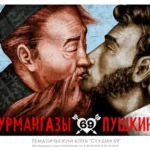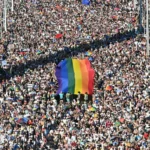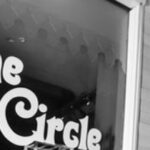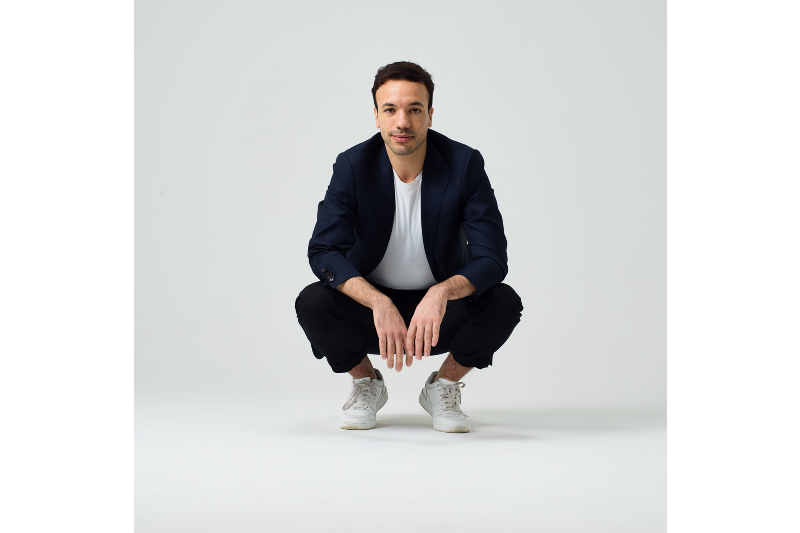Photo credit: Shed Mojahid
Article by Hugo Mega (edited by Alyssa Lepage)
I used to think that “coming out” was going to be the hardest part of being gay. That, being free to be me, I could finally stop pretending. I would be able to drop the heteronormative disguise that I used to wear, to ensure that I belonged and that I felt safe. Little did I know that in the years that followed, more often than not, I would find myself butch-ing up, trying to be more masculine than what I naturally was. How did I find myself here again?
Like walking on thin ice, any false move I made, could easily throw me back into a loop of old patterns that condition my ways of being and behaving without me even noticing it.
Tired of this self-limiting pattern, I decided to confront my beliefs around masculinity. Since then I’ve been engaged in deconstructing my conditioning and notions of what it means to be a man. In the process of deconstructing my beliefs it was difficult to avoid one’s own toxic masculinity. I used to believe that being gay absolved me from being toxic like many straight man can be, but I was wrong.
In this article I will be reflecting on personal experiences and different perspectives, to explore how these toxic behaviours are affecting the LGBTQIA+ community. However, as a European, white, cisgender (gender identity that matches the sex assigned at birth), gay man myself, I would like to write directly to those who share similar privileges. These words are also directed to the homosexual community in general and to those who identify as being a man, male or masculine, and who are having or trying (because yes, dating is hard) to have sex with men.
To anyone concerned, this is not an attack on our community nor it is meant to exclude anyone. This is an open invitation to challenge a status quo, especially to those directly contributing and subscribing to it.
What is gay toxic masculinity?
In her article about “Toxic masculinity in the queer space”, Laura Gruebler succinctly defines toxic masculinity as “socially destructive habits that encourage social codes such as misogyny, homophobia, physical and mental violence, or domination.”
The popular dating app status like “masc for masc” (masculine men only looking to sexually interact with other masculine men), or the exclusive, fatphobic, sexist and racist “no fats, no femmes, no asians”, as much as the normalisation of a ghosting culture (disengaging from a relationship by ending all communication without any explanation) are some examples of toxic masculinity “at its best” in gay culture.
Why is it that this toxicity, generally associated with heterosexual men, is growing evermore present in (and not exclusively) the homosexual scene? My immediate answer is: Men will be men (no matter their sexual orientation). By that I mean: uninformed, entitled and privileged. By no means do do I say this to excuse or justify our behaviours. I write this to point out the common red thread that most of us fail to recognise.
Toxic masculinity derives from a heritage of beliefs, actions, and from the perpetuation of behaviours passed down from parent to child, from leaders to followers, generations after generations. It’s like the waste product deriving from centuries of patriarchal conditioning. However different in its expression, heterosexual and homosexual toxic masculinity are undeniably rooted in the same foundational problem. To stop toxic masculinity we must first understand how it originates. In that manner we cannot talk about it without unpacking what patriarchy is and how it affects everyone, not just (gay) men.
Patriarchy is an outdated construction designed to privilege men in our political and societal structures. It prehistorically screams that white, cisgender men are superior. Feminist writer bell hooks (who spells her name in lowercase letters to focus attention on her message rather than herself) draws our awareness to the intersectional nature of this oppressive system by describing it as an “oppression matrix of white supremacist, heterosexist, imperialist, capitalist and ableist patriarchy”. Presented as such, this matrix already suggests how people are predisposed to certain conscious and unconscious behaviours, biases and judgements that oppress others based on their gender, sexual preferences, race, class, physical and mental capacities. Simplistically, patriarchy is all about privilege and power dynamics.
We can not dismantle this oppression if we don’t understand how we are qualifying and attributing power to men. As gay men, having other men at the centre of our desire, it becomes paramount to understand what is supporting our way of relating to each other. In this understanding I underline here the work of the philosopher Olivia Gazalé whose research helped me differentiate virility from masculinity. She states that in order to be granted access to the privileges of patriarchy it is not enough to be assigned as male at birth. One needs to prove their masculinity through a series of behaviours and actions. According to standard definitions, masculinity is described as the “qualities or attributes regarded as characteristic of men”, whilst virility is defined by a set of behaviours that conditions, determines and evaluates one’s degree of masculinity (which is the same as to say, one’s degree of power, therefore one’s degree of privilege).
As Gazalé thoroughly deconstructs in her book “Le myth de la virilité”, virility is a trap that oppresses all who fail to live up to the “right” standards of masculinity. In that fragile perspective, patriarchy reinforces the binary, of “me versus the other” and masculinity over femininity. Feminine men are deemed as lesser than the virile cisgender masculine man. However inferior, these “other” men remain – by comparison – privileged over women. Consequentially, being a part of a male dominated society, women who adopt these oppressive or more “masculine” qualities, become – by comparison – privileged over women who do not adhere to these dominant behaviours. This idea of hierarchy then continues cascading down, overcasting oppression over all those who don’t conform to this norm and gender binary.
How does this influence the way we rank and relate to each other?
Pairing this vision of the binary proposed by Olivia Gazalé with the matrix of oppression suggested by bell hooks, this is how I hypothetically see this hierarchical pyramid of privilege unfold in our western societal context:
- At the top, there is the white, cisgender, heterosexual, wealthy male – privileged over people of other races, colours and genders, no matter their wealth. This male will also be privileged over less masculine or less virile, cisgender, heterosexual, wealthy men. That less virile man “is” still privileged compared to a gay man, who – regardless of their sexuality – remains privileged over women, non binary and trans people.
- Then, this cycle starts over within the gay ecosystem. The virile, white, wealthy gay man – even though inferior to his straight equivalent – now stands at the top of the chain, clearly superior to the more feminine gay man, regardless of their race, colour and wealth. This stratification interlaces privilege with attraction and power dynamics. The one playing the “active” role, urbanely described as the “top”, is considered as superior to the one playing the “passive” role, called the “bottom”. Versatile men and more virile bottoms remain superior to the more effeminate ones. These are still seen and considered by some of the “higher ranked” as superior to drag queens, gender non-conforming and trans people.
There are obvious exceptions to this pyramid scheme, especially when external power factors like status, fame and influence come to play in these equations.
Still, when we perpetuate this hierarchy through our beliefs, behaviours and actions, we are choosing power and privilege over connection. Virile and patriarchal conditioning serves then as a measurement tool of one’s power, influence and privilege, to which toxic masculinity becomes the marginalising dialogue that determines who belongs where in the hierarchy.
Reflecting upon this, I could not avoid seeing another perspective of this ladder in how the gay community stereotypes its own members based on body types, age and physical attributes.
We differentiate the bears from the wolves, the twinks from the jocks, the daddies from the chasers, the tops from the bottoms. Crisscross their attributes and the variable options produce a list of endless labels. Historically oppressed or marginalised, all gay men yearn for validation in one way or another. In that perspective this categorising was probably a necessary process to affirming our belonging and existence as gay men. The problem emerges when we start to attribute power to certain labels according to the earlier stated hierarchical privileges. Endorsed by some of these categories, the hairier, the taller, the more muscular, the more masculine you are, the more desirable you will be and the higher you will tend to rank in the gay “food chain”. The more power and privilege one gets, the more one feels entitled to certain behaviours and actions. Especially when interacting with other labels threatens the image you are trying to create and the status you want to prevail. As soon as you demonstrate qualities associated with feminine behaviour or are seen that way from an outsider’s point of reference (because all these completely vary according to one’s individual conditioning and definitions of what femininity/masculinity is) you immediately start to tumble down the chain, ranking lower on the hierarchy.
As Gabriel Arana said in THEM: “The result of this relentless social conditioning is that every gay man inherits an identity crisis: They must reconcile their sense of masculinity with their failure to conform to its compulsory heterosexuality.”
This reconciliation between masculinity, conformity and (potential) desire to fit in somewhere, with “someone like me”, finally backfires when the expectations don’t match those “boxes” or one’s own desires. For example, specific categories such as “the Twink” – usually thinner and generally hairless men – are associated with an image of boyhood, which is to say, more infantile, feminine and lacking virility. The members of these category tend to be or present as younger and are generally associated with a more passive sexual role. These associations perpetuate the power dynamics that rank them as lower on the “masculinity scale” in relation to categories deemed more masculine. If a so-called Twink does not identify with the qualities associated with this label, they may find themselves feeling the pressure to change. Conflictingly they might butch up their mannerisms or work out more to change their physical appearance. All this in the hopes to look and feel differently in order to socially and sexually integrate and interact with different gay demographics.
How does this impact us on a personal level?
One of my close friends once mentioned how “(many) gay men are not attracted to other gay men”. He emphasised that many men are attracted not to a person but to a performance of masculinity achieved by an individual. One can easily forecast a projection here: conditioned by heterosexism, we are perpetually (sexually) fantasising and idolising straight men’s masculinity. This specimen is simultaneously what we despise and what we renounce to be, yet desire nevertheless. Are we still trying to reconcile this failure to conform to heterosexuality by trying to become one with (by possessing or converting) its representatives?
Performing masculinity, being emotionally unavailable, excluding, marginalising, playing hard to get, avoiding commitment have become other ways to conform and exercise power dynamics. In this view, the more one looks or passes as straight, the higher the chance to become socially normalised and the object of desire for other gay men. This snowballs the pressure to portray and perform virile masculinity. For many, this search for validation comes with a compromise, a set of aesthetics and a general lack of an actual deep, psychological and emotional authenticity.
This compromise can not be dissociated from the subliminal and direct conditioning that gay porn has had on our (sexual) development and expression. This medium has become increasingly more violent with predominantly abusive dynamics. Porn, however misleading, remains for many, a reference point during our pre and post closeted existence. Above it all, it continues to be today the birthplace of dysfunctional physical and sexual expectations. Weaving this back to privilege and the underlying desire to belong, combined with a desire for “that which I couldn’t be” (straight), we get the perfect recipe for code-switching dynamics. Meaning me shape-shifting myself and my personality by bargaining my authenticity to fit certain purposes, desires or socio-professional contexts. A popular example of a vicious circle of self-loathing thoughts steaming from this compromise could easily sound like: as a gay man, I “should” be having sex, lots of it. If I’m not, then there’s something wrong with me. (Dating apps will easily point it out and help me make a list of what’s wrong!) I feel powerless and yearn for some control. So I slowly adapt and adopt new behaviours, so that I can have easier access to sex. Because I know what’s wrong with me, which I’ve tried to cover up or transform, I become hyper-aware of what is wrong with the one wanting to have sex with me. So before I realise it, I am contributing to the conditioning of others through misogyny and femme-phobia. This behaviour leads us to living fragmented lives, meaning that I behave differently according to who is around me. For me, this right here is the official birthplace of toxic masculinity, where I direct this behaviour towards myself and choose to conform to the privileging norms. If I take on these conditions and repress myself, how could I not cast these onto others too?
To contradict our authenticity, our innate need for validation and belonging will instinctively stir up defence mechanisms of all sorts. These harmful self-protecting strategies naturally become tools of oppression and discrimination. These defences are a natural response to these restricting roles, labels, stereotypes and privileges we’ve established. It is through this defensive response that toxic behaviors such as femme-phobia, fat-phobia, bigotry, body dysmorphia and disrespect become consented, normalised and endlessly perpetuated.
This can only lead to anxiety, more discrimination, violence and negative consequences to all involved. Gay toxic masculinity is then, not only a byproduct of heteronormative patriarchy. It is a constant endorsement, a weapon, a defence mechanism and a mating ritual practiced within our own community.
So, to unpack and deconstruct (gay) toxic masculinity, is to unravel oneself within the patriarchal context. We do so by looking within and questioning one’s masculine constructions and expectations. By choosing authenticity and intimacy over commodity and privilege. By answering the questions: What are the values and judgements supporting my actions? How are these actions a reflection of my privilege and entitlement? What rights do they grant me, that I repress in others? Masculinity as we’ve known it is an old man-made fatalist construction. So, I invite everyone to deconstruct themselves and redefine masculinity on their own terms. The concept of masculinity today is growing ever more fluid, inclusive and more creative than ever.
Gender, as we know it – as much as the patriarchy – exists on a wide spectrum and on a continuum, so there is no specific end to it. Still today, I’m not fully deconstructed nor completely immune to my own toxic behaviours. I still find myself reproducing old patterns and interacting with new ones that I do not wish to support. But I’m working on it! In writing this article, I hope to inspire our community, to “do the work” and step closer together. It will take a village to break free from these toxic patterns. So, I write to all the men who I wish to see liberated and I do so with love, an honest love for men.
Hugo Mega is a transformative coach, imagery therapist and activist dedicated to help deconstruct patriarchy. He is an international coach trainer and mentor, and a program director at Coach Masters Academy. He is the co-founder of @Liminal.Brussels where he is currently facilitating conversations about masculinity, feminism and personal development.
You may also like
-

No One Left Behind: Inside Brussels’ Rainbow Refugee Committee
For LGBTQIA+ people forced to flee their homes, Belgium can be a place of safety—but
-

Kazakhstan: When Being Queer Becomes a Crime
This week, Kazakhstan moved closer to adopting a new law that would restrict what it
-

Marching Anyway: What Budapest Pride Tells Europe
Hungary’s LGBTQIA+ community is once again at the centre of a political storm. Hungarian police
-

More Fun Than Monopoly, More Queer Than Scrabble
Join us every Sunday for a cozy queer board game afternoon in Brussels! This event
-

Save the Crazy Circle – Keep Brussels’ Queer Joy Alive
Two years ago, you helped us save The Crazy Circle from closing its doors. Thanks to your

